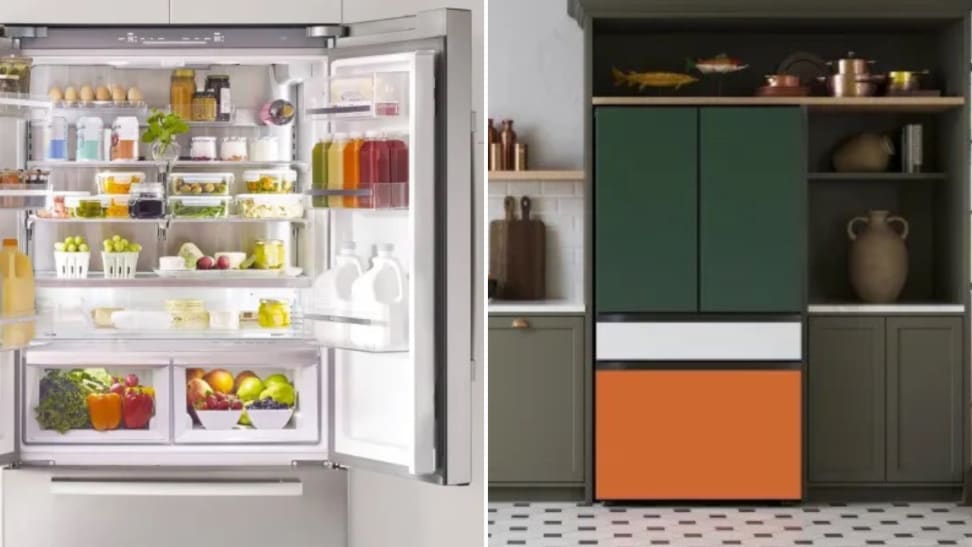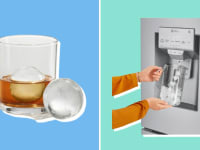Shopping for a new fridge? Pay attention to these 5 things
Details matter in refrigerator design
 Credit:
Reviewed / Bosch/ Samsung
Credit:
Reviewed / Bosch/ Samsung
Products are chosen independently by our editors. Purchases made through our links may earn us a commission.
If you haven't shopped for a fridge in a while, you may be surprised by how much has changed in the world of fridges in just the past few years. There are now more options than ever, and making sense of what's out there can be a daunting task.
Here, we've broken down the most important fridge design features, analyzing the big and little details that make a fridge worth purchasing.
One of the most obvious ways that fridges differentiate themselves is their design details, and there are several key areas to look out for.
1. How the main fixtures are constructed

There's especially no crying over spilled milk when you have spill-capture shelves preventing an even worse mess.
Shelves and door bins aren't created equal. While most are made of plastic, the differences in quality between the types of plastic being used are immediately apparent in how they feel and move.
Some plastic fixtures can feel robust and sturdy while others may make you nervous you might break them.
Shelves are a key area to pay attention to: Whether made of plastic, glass, or simple wire racks (usually found in the freezers of budget buys), their design is of paramount importance. While high-quality materials can make the fridge look and feel better, the most important aspect may be the spill-capture lip (pictured above).
When a spill-capture lip is present, the shelf is surrounded by a plastic or metal bezel that can help corral liquids before they have a chance to drip down to a shelf below, creating an even bigger mess. Believe us when we say, it's easy to disregard the value of a spill-capture lip until something spills in your fridge and drips everywhere.
Another important fridge-design feature is how moveable the shelves or other fixtures are. Most shelves and bins will have several slots where they can be repositioned. Premium models may even have shelves that fold up or under themselves to allow additional headroom for taller objects stored below.
2. How the fixtures maximize storage

What storage options does the fridge provide in addition to shelves and door bins?
In addition to shelf design, innovative storage features are an important consideration in overall fridge design. For most fridges, this means the drawers, bins, and crispers, but other fridges go above and beyond in what they offer.
The standard fridge has a series of door bins and shelves for storage. You should expect all of these to be able to be repositioned, though different fridges have different degrees to which you can customize them.
Most door bins are small, but there should be at least one door bin that can house a gallon container to allow for larger jugs and bottles to be stored.
Other manufacturers have their own unique flourishes, such as Midea's pull-out tray or Bosch's FlexBar, which allows you to set up bins and shelves along the back of the fridge to suit your needs.
Drawers are an interesting fixture to evaluate. On the upside, they allow for compartmentalization and better organization. The downside is they're not as space-efficient as a shelf. In general, if you're really looking to maximize space, look for a fridge with the fewest drawers.

Most fridges won't have a deli net, but fixtures like this that take advantage of the space under shelves can help maximize your storage space.
Other fixtures tend to offer additional organization opportunities, like snack bins, full-width deli drawers, slide-out shelves, and even a deli net.
3. Water and ice dispensers

The through-the-door dispenser can be extremely convenient—if you're planning to use it.
Two of the most popular extra fixtures are an internal ice maker and an ice-and-water dispenser.
Through-the-door dispensers used to be the most common, but more manufactures have introduced lower-maintenance internal dispensers, like that in the Bosch B36CT80SNS, which take up less storage space and encounter less service issues.
A separate ice maker in the freezer also allows some specialty fridges to have unique dispensers, like the LG model that produces spherical ice, and many Samsung models that produce two different types of ice.
While many users will love having a dispenser in their fridge, they're not for everyone. If you don't think you'll use one much, lack a water hookup, or are just looking for a second fridge for the garage, don't get one. Dispensers all tack on some extra cost, and their infrastructure can lower the total storage available.
4. Lighting impacts your fridge experience

Once you've used a fridge with LED lighting, you really notice the difference going back to a single-bulb design.
We've come a long way from fridges that sport a single 40-watt bulb as the sole means of illuminating its interior. If you're used to a fridge with a similar setup, trust us: Look into LED lighting.
A traditional bulb setup makes the top shelf extra bright, but objects stored lower down are left in the shadows. LEDs are often built into the top and sides of the fridge, without taking up extra space, and evenly illuminating your food from every angle. Not only does this greatly improve the ability to find what you want, but it just feels better to use the fridge when you’re better able to see what's inside.
Being able to find your food faster isn't just a better user experience: You'll also be standing with the door open for less time, reducing energy waste.
5. Exterior design choices are on the rise

Samsung's Bespoke line-up lets you pick the colors of individual panels, or custom-print your own designs onto them.
The most obvious way a fridge can differentiate itself is with its exterior design. This is an area where, in the past, fridge manufacturers didn't always pay the most attention. For a long time, the only feature you'd see outside a fridge was a through-the-door dispenser, and you'd be lucky to see more finish options than white, black, and stainless steel.
More recently, however, several companies have stepped up to offer a greater degree of customization for the exterior of your fridge.
GE's Café line allows users to choose between interesting twists on the standard three finishes, plus offers six different designs for their handles: brushed bronze, brushed copper, brushed black, brushed stainless, brushed brass, flat black. These options allow Café fridges to more closely match the rest of your kitchen, and they look significantly more high-end than the average matte-white-finish budget buy.
Of course, the company that has really been making a splash in this area is Samsung. Samsung's Bespoke line-up of appliances lets you mix and match various colored panels across fridges and the rest of the manufacturer's appliance offerings.
Currently, Samsung's Bespoke line-up consists of seven color options for glass-finished panels and four colors for the steel finish. For a standard French-door, that means 343 total combinations for glass, and 64 for steel. If you have a Bespoke French-door with a flex drawer, that's a whopping 2401 combinations of glass-finished panels and and 256 for steel.
And that's not counting the ability to upload your own images to create customized panels. It's truly the ultimate in customizing the look of your kitchen.
More on fridges
- The Best Counter-Depth Fridges We've Tested
- The Best Refrigerators We've Tested
- 4 best garage refrigerators to store extra drinks and food
- How much should you spend on a fridge?
- The Best Side-by-side Refrigerators We've Tested
- 10 great refrigerators and freezers to store all your extra food
- 10 things to consider when buying a refrigerator
- 8 refrigerator features that work smarter not harder


